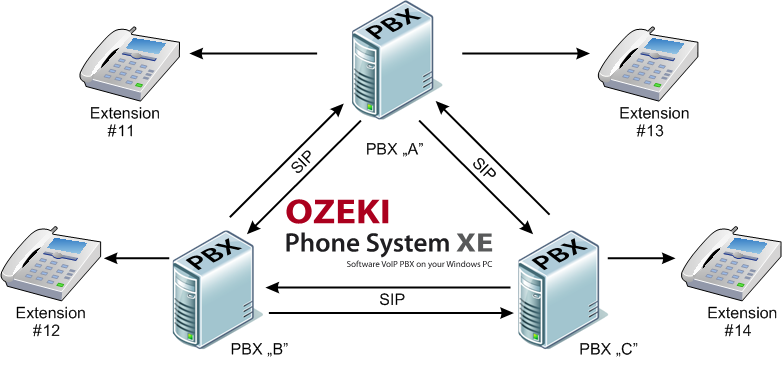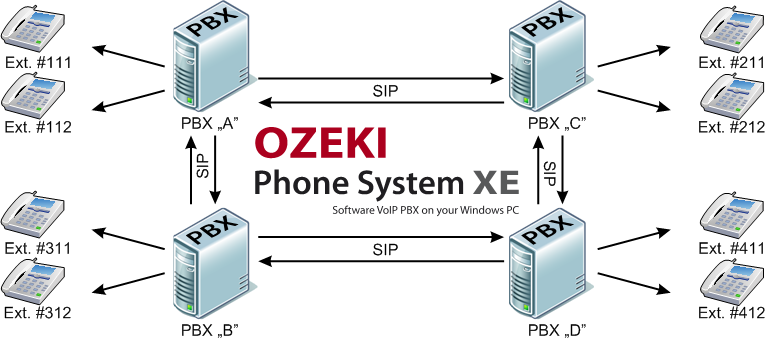What is VoIP Cluster?
In this article you can read about an advanced telecommunication system, the VoIP cluster, and about why this system is important for a company's life. Those companies which intend to have international, even intercontinental relations should read this page carefully.
VoIP, or Voice over Internet Protocol is the technology used in every kind of Internet-based communication: every time a user initiates a message or a call through the Internet, the VoIP protocol manages the transmission of the data packets.
A VoIP cluster is a set of IP PBXs (Internet Protocol Public Branch Exchanges or Session Initiation Protocol (SIP) servers) that are connected to each other. These servers individually are the centres of a unique communication system, but by the connection of them, a greater system can be created. Of course, these servers can be connected through the Internet, what means that you and your company can have an access to different servers from all around the world.
VoIP Cluster Types
There are two types of VoIP clusters: there is one where the PBXs are connected to be one "big" server, and the other one where all the PBXs remain what they were designed to be, but they get connected. Let us see how the different types are used:
-
when the servers are connected into a great system, the capacity of this centre
will be extremely high and all the features of the PBXs will be available. On the
other hand, these PBXs can help and take each other's job, what means that the
reliability of such a system is much greater than the single one.
Since these servers work and behave as one server, the distribution of the extensions will be the same as in the case of only one PBX: all the SIP clients must have a unique extension number.
The advantage of this solution is that it does not matter which PBX the extensions are connected to, and the extension numbers are easy to manage and to reach.
Figure 1 represents a model system that uses this cluster:
- PBX "A", PBX "B" and PBX "C" are connected into one system with SIP connections.
- Since they are recognised by the extensions as one PBX, all the extensions can be numbered in order, without taking into consideration which PBX they belong to.
- So Extension 11 and Extension 12 belongs to the same great system, it does not matter that Extension 11 is connected to PBX "A" and Extension 12 is connected to PBX "B".
- The same is true in the case of Extension 13 and Extension 14.

Figure 1 - The PBXs are connected into one great system and their extensions
-
if the servers remain "individual" within the greater system, all the extensions
must be connected to the proper PBX (according to the place or other aspect of
distribution where the extensions belong to). The same extension numbers can be
used in the different PBXs, but a prefix (another number or digit) must be put
before the extension number in order to make difference among the same ones.
These prefixes are the same as the area codes used in the traditional phoning technology.
In this case the PBXs are connected through SIP, similarly to the other type but when numbering the extensions, the admin must take into consideration which extension belongs to which PBX: so if the admin wants to give "11" for an extension, at least one digit must be given to this extension in order to avoid coincidence.
For this, the extension of PBX "A" that is going to have "11" as the extension number, must have "111" to be distinguished from Extension 211 that is connected to PBX "C". Figure 2 explains the structure of this system:

Figure 2 - The system that consists of individual PBXs connected together and their extensions VoIP Clusters with Ozeki
In practice, VoIP clusters are used in the case of the traditional PSTN systems and in cases when more than one IP PBXs are connected. If you have an already existing PBX and want to modernise your system and extned your opportunities, you can do it with the Ozeki Phone System and with a simple configuration.
By having the Ozeki Phone System in your offices, you can enjoy using all the features that this system provides, with or without another system. With the Ozeki Phone System, you can achieve a high quality, modern and absolutely reliable communication system that serves you professionally, fulfilling all the communication needs you may have.
Ozeki Phone System is a high-technology solution that is capable for managing and even creating both types of VoIP clusters. If you need this kind of "system of systems", take a look at our pages:
